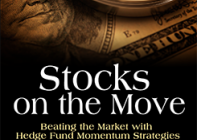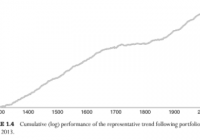Trend Following Doesn’t Work For Stocks
Summary Applying classic trend following models to stocks is very dangerous. If however you are willing to adapt and move to momentum strategies, your chances will greatly improve. Classic trend following will fail on stocks. Stocks have many unique properties that must be taken into account. Momentum strategies provide a solution and a much higher success probability than trend following. There’s a good reason why most professionals who apply models similar to trend following to stocks call them momentum models. It’s not just a clever rebranding, it’s really a very different game. To blindly cling to trend following as a religion, disregarding any real world evidence and attacking anyone presenting ideas that differ to the trend following mantra is not only unprofessional, it’s outright dangerous. I bet you’re wondering about the title of this article. After all, I do employ quantitative models based on trend following logic on single stocks in quite large scale myself in my business. Some models that I’ve been using for many years produce very attractive returns on single stocks. So why am I writing such a provocative title? It’s not only to get you to click on it (though that worked, didn’t it?). It seems as some people stop reading after such a headline, and simply go on an all out counter attack, without bothering to read or understand the rest. Well, I’m guessing they’re no longer reading, so let’s get down to the real deal. If you apply a standard trend following model on stocks, you will lose. The operative word here being ‘standard’. Trend following on futures is quite easy in comparison. It’s much more complex to model strategies on equities. Most people simply ignore the difficult parts and hope for the best. That’s not an advisable course of action. Doing really proper strategy modeling on stocks may be outside of the budgets and technical capability of most retail traders. Even if you get your models right, you can’t treat stocks like futures. There are a few key differences, that require you to adjust your expectations and approach. Stocks are cash instruments and need to be funded. You have a clear limit to how much exposure you can take on. You do not have a pool of cash anymore to be placed in govvies. You cannot have your client fund his managed account at 20%, putting up 200,000 for a million notional. Stocks are a very homogeneous group. The internal correlation is massive. They will all go up and down at the same time with some small variation. In a bull market, they all go up. In a bear market they all go down. Diversification becomes much less important. You end up mainly trading beta anyhow. That can be ok, but if you’re under the delusion that you’re a great stock picker for buying high beta stocks in a bull market, you’re in for a nasty surprise when the bull leaves the field. Stocks are prone to rapid vola expansion in bear markets. Your neatly calculated risk measurements goes right out the window real quick. Suddenly all those stocks that were doing so nicely all fall down hard at the same time. As you start entering shorts on new lows, the stocks tend to make huge, albeit temporary, jumps up. As you’re forced to shut down positions not to blow your portfolio up, they fall back down. The short side of the single equity game is a veritable nightmare for standard trend following models. Modelling strategies on equities properly require total return series and dividends details. You need to analyze the total return series, trade the price series and have logic in place for how to handle the dividends when they come in. The potential for survivorship bias in single stock strategies is massive. If you run a strategy on the S&P 500 stocks for ten years back, base on the current S&P500 constituents, you’ll get an extremely distorted picture. Many of those stocks are in the index because they had a massive price increase. They were not in before. They wouldn’t have been on your radar when they had those returns. Check your data. Applying standard trend following models on single stocks is dumb. It doesn’t matter whether you use breakout channels, moving averages or other indicators. Toggling parameters up and down won’t help. People who say that you should apply standard trend models on stocks also tend to be the people who lacks experience with professional trading or quant modeling but don’t let that stop them from selling defunct trading system to unsuspecting retail traders at a few thousand bucks a pop. The most common arguments for applying standard trend following models on stocks is based on anecdotal evidence and classic fallacies. The first kind would be to point out that some hedge fund seems to be doing it with good results, without of course knowing anything about how they have adapted models for stocks, or to point out that someone’s cousin got rich doing it. Hedge funds certainly don’t run standard trend models on single stocks, though the often simplify the marketing pitch by calling it trend or momentum strategies. I can assure you that real hedge funds are a little more sophisticated and are fully aware of the special situation in stocks. As for the cousin, well, going on anecdotal evidence anything is possible. Apparently there are people who made gazillions trading on financial astrology too. The fallacies are usually about mentioning stocks that went up a few thousand percent, and how trend following models totally would have captured this. Disregarding of course the probabilities of having covered that stock when it was a small cap, the many times you would have been shaken out along the way, the allocation to this stock compared to the many that did less well etc. A massive simplification of the real world. This argument concentrates on the position level, and on the pro side we’re just concerned with portfolio level results. Does trend following really not work on stocks? If you’re willing to adapt your models and do something closer to momentum trading, you’ll do just fine. But the return expectations cannot be the same as for futures. Not that it’s necessarily lower, that’s not the point. But you’ll be much more dependent on the overall state of the equity markets. You can’t expect to make a killing in 2008 because you were supposedly short all the stocks. Would be nice if the real world worked like that though. How do I know that standard trend following does not work on stocks? Besides the common sense arguments of having lost the advantages of diversification and leverage, there’s quite a bit of actual, empiric evidence. I do this for a living. I have no reason to say that something works or does not work, unless that’s based on experience and research. I’ve modelled thousands of iterations of trend following models on every major index in the world. I’ve arrived at models that work and models that don’t. Standard trend models don’t. So what can be done to make trend following work on stocks? 1. Don’t go short. Kill the short leg of your strategy. Replace it with a short index overlay if you have to. 2. Take the state of the overall markets into account. You can’t keep going long in a bear market and expect to gain. 3. Build a ranking methodology to pick the best stocks. Don’t trade the stocks you read about in the news or heard about from your friends. Automatically analyze a large number of stocks and have the best ones selected. 4. Single stock vola can change dramatically over time. Rebalance your position sizes. 5. Trade fewer stocks with larger positions. Yes, that’s right. Counter intuitive isn’t it? Don’t be fooled into thinking that you’ve got more diversification with 50 stocks than with 20. They’re all beta bets and you just need to get the individual event risk down to reasonable levels. Beyond that, further diversification will worsen your results. Don’t believe me? Run a few hundred iterations of your model and tell me what you find. 6. Expect to have great returns in bull markets and aim to make your strategy lose as little as possible in bear markets. Religious dogma about a trading methodology is not helping anyone but system salesmen. It’s dangerous to view yourself as a trend follower. A much more pragmatic way would be to look at yourself as a systematic trader. Investigate what works and how it works. Trend following is a great concept but be very aware of its limitations. Adapt your rules to reality and overlay satellite strategies where needed. Hard work, quantitative modelling, research and pragmatism will get you to your goal. My new book details how to go about constructing a robust equity momentum strategy and offers a complete methololgy for implementing it. Released in June 2015, Stocks on the Move is now available in paperback and Kindle. Disclosure: The author has no positions in any stocks mentioned, and no plans to initiate any positions within the next 72 hours. (More…) The author wrote this article themselves, and it expresses their own opinions. The author is not receiving compensation for it. The author has no business relationship with any company whose stock is mentioned in this article.

